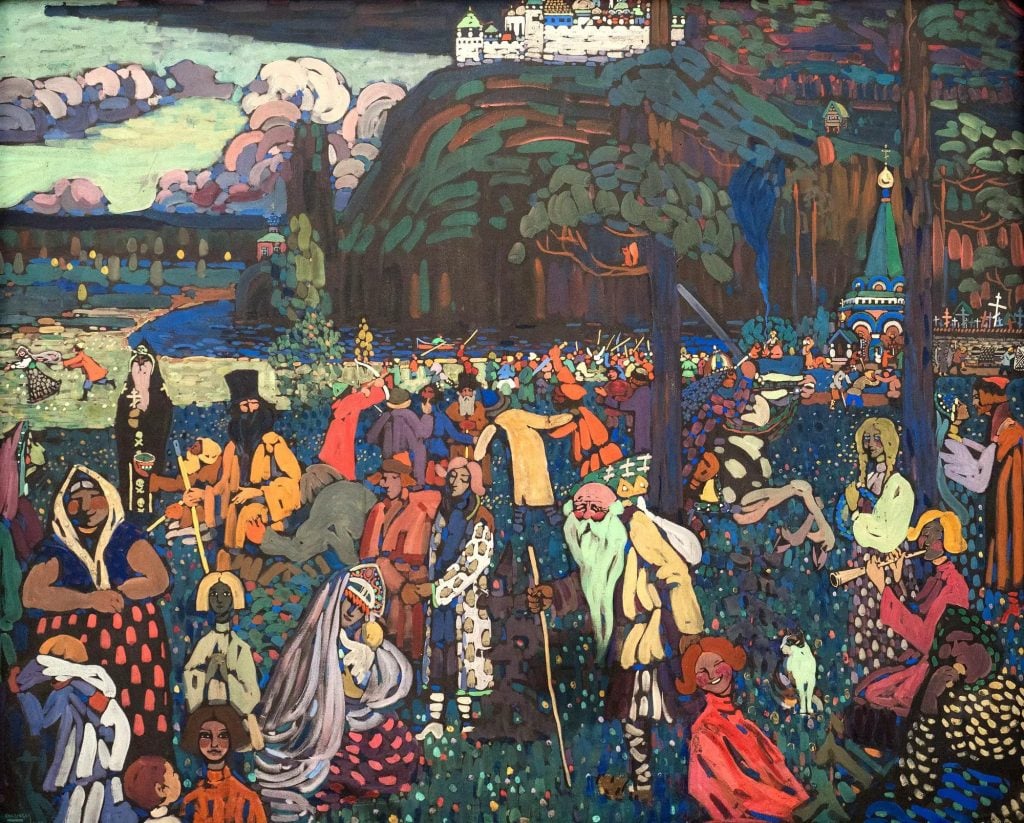Law & Politics
A Kandinsky Painting Sold During World War II Should Be Returned to the Heirs of Its Jewish Owners, an Advisory Panel Ruled
Once owned by a Dutch couple, the painting was auctioned just months after the Nazis occupied the Netherlands.

Once owned by a Dutch couple, the painting was auctioned just months after the Nazis occupied the Netherlands.

Taylor Dafoe

An advisory panel for the German government has ruled that a painting by Wassily Kandinsky should be returned to the heirs of the Jewish family that owned it before it was auctioned off during World War II.
The artwork, Kandinsky’s Colorful Life from 1907, belonged to the Amsterdam-based couple Hedwig and Emanuel Albert Lewenstein and was bequeathed to their two sons upon their deaths before the war. The painting was on loan at the Stedelijk Museum when it was moved to the Frederik Muller & Co. auction house in early September 1940—just months after the Nazi’s occupied the Netherlands. The canvas sold on October 9, 1940.
How Kandinsky’s painting ended up on the auction block is unclear. The state-owned Bavarian bank BayernLB, which currently owns the artwork, argued that the Lewensteins could have consigned the piece themselves. But by that point, the Lewensteins’ two sons—Robert and Wilhelmine—had fled the Netherlands to New York and Mozambique, respectively.
“It cannot be proven on whose initiative the painting was sold as part of the Lewenstein estate to the auction house Frederik Muller & Co. at the auction,” the panel said Tuesday, according to the Associated Press.
Though there is no documentation suggesting that Colorful Life was taken from the Lewensteins under duress, the German advisory commission concluded that “the painting was seized as a result of persecution” against the family, who were Jewish. The panel recommended that BayernLB return the painting to the Lewensteins’ heirs.
The commission’s recommendations are not legally binding, though they have been consistently honored in past cases. In a statement to the New York Times, the bank stopped short of promising to return the Kandinsky canvas, saying only that it would take the commission’s advice into account “in the context of its decision on how to proceed further.”
“My late parents and grandparents would be extremely pleased about the decision in this matter,” Francesca Davis, the granddaughter of Hedwig and Emanuel Lewenstein, told the Times.
She and other Lewenstein heirs were represented in the case by the Mondex Corporation, a Toronto-based company that specializes in the restitution of artworks and other pieces of cultural property taken during the Holocaust.
Mondex’s founder, James Palmer, said in a statement that the panel “has made a considerable contribution to ensuring that the victims of National Socialism receive justice.” Palmer’s team first filed a lawsuit for the painting’s return in 2017.
Completed in 1907, Colorful Life depicts of dozens of colorful characters celebrating in a dreamy mountainside landscape. The canvas marked a moment of transition for Kandinsky as he moved away from figuration and increasingly embraced the type of geometric abstraction for which he’s now known.
“The challenge that fascinated me above all was creating a mixture of masses, stains and lines,” the Russian artist wrote of the canvas. “I used a ‘bird’s eye view’ to position shapes above each other. In order to organize particular areas and brushstrokes the way I wanted, I had to find substantiation in terms of perspective in each case.”
This is not the first time the Lewenstein family has sought the return of a Kandinsky lost during World War II. In 2021, Amsterdam officials announced that the city would return the artist’s 1909 work Painting With Houses to the family, ending a years-long legal battle.
The decision led to a reform of the Dutch Restitutions Committee’s policy on Nazi-looted art. The new guidelines stipulate that, “if the original owner was a private individual belonging to a persecuted group, involuntary expropriation is presumed if it occurred in the Netherlands after 10 May 1940.”